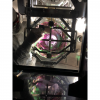Ops Shift Log: 03/07/2018, Day Shift 16:00 – 08:00 (08:00 - 16:00) Time - UTC (PT)
State of H1: Unlocked during vent for upgrades
Intent Bit: Engineering
Support: X
Incoming Operator: N/A
Shift Summary: Commissioning and upgrade work continues at both end stations. Vacuum work at Mid-Y. Alignment of the PSL 70W laser.
Activity Log: Time - UTC (PT)
15:30 (07:30) Terry – In LVEA at ISCT6
16:00 (08:00) Start of shift
16:27 (08:27) Joel from RDO on site to deliver parts for tractor
16:43 (08:43) Marc – Going into the LVEA
16:44 (08:44) HFD – On site to run smoke tests at End-Y
16:46 (08:46) Sheila – Going to HAM6
16:57 (08:57) Marc – Out of the LVEA
17:11 (09:11) Travis – Going to LVEA to look for parts
17:17 (09:17) Richard – Going to LVEA to find headsets
17:30 (09:30) Travis – Out of the LVEA
17:31 (09:31) Jim – Going to End-X to lock the ISI
17:40 (09:40) Nutsinee – Going to ISCT6
17:58 (09:58) Rick, Niko, & Travis – Going to End-X for PCal work (WP #7404)
18:13 (10:13) Laser hazard at End-X
18:30 (10:30) TJ – Going to HAM6 for cabling work
18:31 (10:31) Jason & Ed – Going into the PSL enclosure for mode matching
18:31 (10:31) Marc – Going into LVEA to look a CRD
18:45 (10:45) Dave B. – Going into H2 building to work on 3IFO computers
18:50 (10:50) Betsy – Going to End-Y for chamber closeout work
18:54 (10:54) Chandra – Going to Mid-Y
18:56 (18:56) Corey – Going over the tube bridge to look for shipping container
19:04 (11:04) Elizabeth – Going to both end stations for marking off electrical exclusion areas
19:22 (11:22) Jason & Ed – Out of the PSL Enclosure
19:23 (11:23) Karen – Cleaning at Mid-Y
19:34 (11:34) Sheila – Out of the LVEA
19:38 (11:38) Nutsinee – Out of the LVEA
20:06 (12:06) Karen – Finished at Mid-Y
20:15 (12:15) Elizabeth – Back from end stations
20:21 (12:21) Rick, Niko, & Travis – Leaving End-X
20:21 (12:21) Laser Safe at End-X
20:54 (12:54) TJ – Out of the LVEA
21:02 (13:02) Terry – Out of the LVEA
21:03 (13:03) Contractor on site to see Chandra
21:14 (13:14) Karen – Cleaning in the H2 building
21:20 (13:20) Elizabeth – Into the LVEA for marking electrical exclusion zones
21:22 (13:22) Filiberto – Going to End-Y for ground loop checks
21:23 (13:23) Apollo crew – Taking one-ton to End-X to drop off pallet for SEI
21:27 (13:27) Jason & Ed – Into the PSL Enclosure for 70W amp work
21:31 (13:31) Karen – Finished in H2 building. – Going to Wood shop
21:46 (13:46) Sheila – Going to HAM6
21:44 (13:44) Marc – Going into LVEA to check the CRD
22:54 (13:54) Nutsinee – Going to HAM6
21:55 (13:55) Terry – Going to HAM6
22:15 (14:15) TJ – Out of the LVEA
22:41 (14:41) Rick, Evan, Darkhan, Niko – Going to End-Y for PCal
22:43 (14:43) Jason & Ed – Out of the PSL Enclosure
23:22 (15:22) Jim & TJ – Going to End-Y to work on relocking the ISI
23:38 (15:38) Marc – Going into the LVEA to check on the CRD
00:00 (16:00) End of Shift
00:03 (16:03) Marc – Out of the LVEA


























